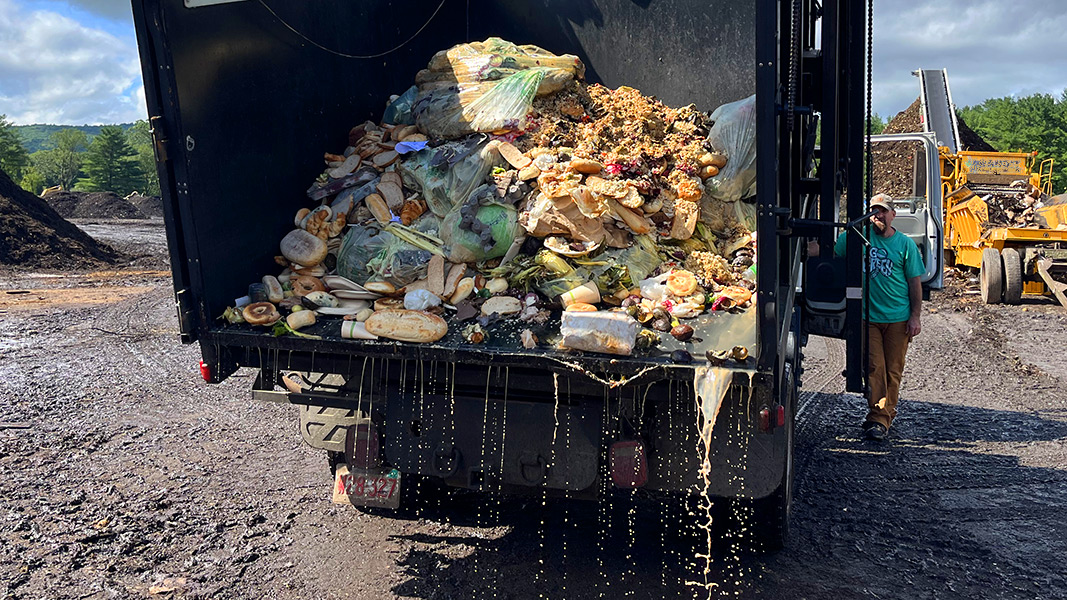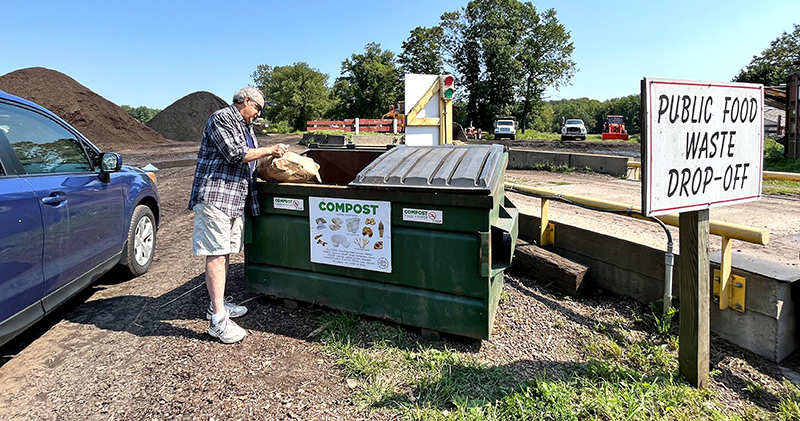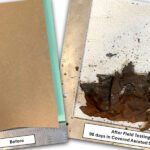Top: About 80% of incoming food waste is from the commercial sector and 20% is from households.
Robert Spencer
As a veteran composting facility operator and BioCycle Contributing Editor for over 30 years, I find it hopeful for the organics recycling industry to have a new generation of company owners not only take over for their parents, but add new perspective and innovation to operations. Such is the case with Martin’s Farm in Greenfield, Massachusetts, located in an agricultural community in the Connecticut River valley of western Massachusetts. In the early 1980s, Bob Martin started collecting food waste to feed his pigs, as well as a collection business for paper and cardboard to grind into bedding for his cows. Once the quantities collected exceeded what could be used on the farm, he progressed in 1987 to composting those materials with the intent of producing compost for his hay and produce fields, and to generate revenue for the farm. Martin also experimented with using heat from compost piles for his shop and office.

Bob Martin (left), founder of Martin’s Farm, and Adam Martin, the second generation owner of the composting facility.
Although Bob Martin’s son Adam had worked at the composting facility part-time in high school, Adam recalls that “Dad was concerned about the quality of life I would have if I took over the composting facility since it is hard work. So he encouraged me to find another career. I took his advice and moved to Wyoming, graduated from diesel mechanics school, and I also got an associate degree in business administration.”
In 2010, after a couple of years of missionary work in India and South Africa, Adam returned to the farm and started managing the composting operation. Then, in 2014 Bob Martin sold the business to Adam and his wife Alex and moved to Kentucky where he started another composting facility. Unfortunately, Bob Martin succumbed to COVID in August 2021, as did his wife. Adam said that his Dad liked to visit the farm, “get behind the wheel of the front end loader, and see the improvements that were always being made.”
Sumner Martinson was the primary compost staff person with the Massachusetts Department of Environmental Protection (MassDEP) when the state issued a composting permit to Martin’s Farm in 1987. Martinson, now retired, recalls the extensive time that he and Maarten van de Kamp of the Massachusetts Department of Agricultural Resources spent providing technical assistance to the pioneering composting facility.
“Bob Martin recognized the value of composting leaves and agricultural manures to make a soil amendment for his farm fields and to sell to residents,” notes Martinson. “It also generated income from accepting leaves and food waste from surrounding towns. Although Bob studied compost management (he worked full-time as an extension agent at the University of Massachusetts, Amherst) his operation was hampered by an inadequate composting pad and windrow turning equipment. As a result, neighbors complained of odor to the local board of health, so Maarten van de Kamp, who lived in a nearby town, and I started a technical assistance project to improve the composting operation on the farm, an effort that took two years. Farmers have their own way of doing things, so it took time to convince Bob to change some of the practices and improve his pad, windrow construction, and turning.”
Martinson adds that the enticement of state grant funds convinced Bob Martin to make improvements. Funds were used to reduce ponding on the compost pad and replace a bulldozer with a front-end-loader to construct better windrows and improve turning techniques. “The operation was greatly improved, and they added food waste from area supermarkets, colleges, and restaurants to run a successful facility for many years,” he says. “When Adam purchased the farm, he continued to make improvements to the point that Martin’s Farm is probably the best on-farm composting facility in Massachusetts.”
Bob Martin’s collection trucks and front-load containers were sold to Triple T Trucking in Brattleboro, Vermont in 2004; Triple T continues to haul food waste to Martin’s Farm from Massachusetts and Vermont customers. Keene State College in Keene, New Hampshire also has its dining hall food scraps hauled to Martin’s Farm. Adam explains that since he is not in the hauling business, he and his several employees can focus on maximizing throughput of 6,000 tons/year of food waste and bulking agents as allowed by a MassDEP Recycling, Composting and Conversion permit. The farm accepts all BPI Certified compostable products. “Roughly, 80% of incoming food waste is from commercial generators, and 20% is residential — including household food waste dropped off at transfer stations in Franklin County (see sidebar) as well as at our farm,” he estimates. The facility produces about 4,000 cubic yards/year of compost. “I spend lots of time making a high-quality compost product, including our system to remove film plastic,” he adds. “I want a customer for life, not just a quick sale.”
Composting Facility Investments
On a tour of the facility in August 2022, the author was impressed with the extensive equipment that has been purchased to improve operations since visiting several years ago. There was also minimal odor on the site despite it being a hot and humid summer day.
For many years the farm used a windrow turner hooked to a tractor to turn windrows, but found the piles were too small, and turning released odors. A variety of odor control agents were utilized in the recipe, on the windrows, and in a perimeter spray system. Although that helped, it was expensive and the small windrows were constraining operating capacity. Martin’s Farm transitioned to large front-end-loaders to construct and turn much larger windrows. Adam points out that weather can adversely impact composting operations so good equipment is very important.
“The biggest odor control comes from my management,” he explains. “As I grind the food waste and other amendments, I use a Telestack TC124X stacking conveyor to make a pile of about 1,600 cubic yards of material without having to move the conveyor. I then construct a windrow about 15 feet high by 25 feet wide and cover the newly formed windrow with about a foot of ground yard waste, which is very effective at absorbing odors.”

Food waste is ground with yard trimmings and other amendments. The stacking conveyor (far right) creates a pile of blended feedstocks, which are then constructed into windrows. Photos courtesy of Martin’s Farm.
The other important piece of equipment is a Phoenix 2100 trommel screen with interchangeable drums that yield four fractions: 5/16-inch compost, wood tailings, stone, and film plastic. Adam designed and built a vacuum that pulls film plastic, fruit stickers, and biodegradable plastics that have not decomposed out of the compost and residuals, and blows them into a covered 30-cubic yard roll-off container. The stone is used to fill the never-ending low spots that develop on the site. Residuals consist of oversized organics, minus most film plastic, and are reused in the process. Therefore, the only major residual for landfill disposal is film plastic. Inorganic contaminants are manually sorted from the food waste upon delivery, but they are not a significant quantity. The 5/16-inch compost product has minimal visual inorganic contaminants and is sold in bulk for $60/cubic yard. Other products are Loam-Compost, Compo-Mulch, and Compo-Char.
Bob Spencer has been a Contributing Editor to BioCycle for over 30 years. As Executive Director of the Windham Solid Waste Management District in Brattleboro, Vermont, he operates a food scraps composting facility.














